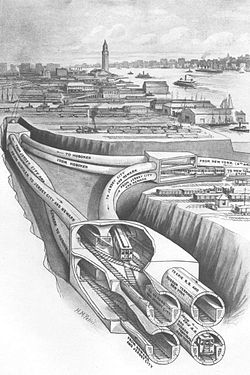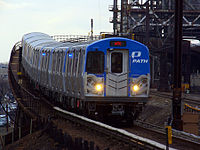- Downtown Hudson Tubes
-
Downtown Hudson Tubes 
1909 illustration of flying junction of Uptown Hudson Tubes in Jersey City which connect to Downtown tubes to the south Overview Location Hudson River Coordinates 40°42′54″N 74°01′28″W / 40.7151°N 74.0244°WCoordinates: 40°42′54″N 74°01′28″W / 40.7151°N 74.0244°W System PATH Start World Trade Center End Exchange Place Operation Opened July 19, 1909 Technical Construction 1874-1908 Length 5,650 ft (1,720 m)[1] Gauge 1,435 mm (4 ft 8 1⁄2 in) Electrified Third rail Lowest elevation 97 ft (30 m) below sea level[1] Tunnel clearance 15.25 ft (4.65 m)[1] The Downtown Hudson Tubes are a pair of tunnels that carry PATH trains under the Hudson River between New York City and Jersey City in the United States. In lower Manhattan the trains travel to and from the World Trade Center station. In Jersey City the trains stop at the Exchange Place station. The tunnels were the second non-waterborne connection between Manhattan and New Jersey and were completed shortly after the uptown Hudson tubes.
The original tubes were built in 1908, to service the Hudson & Manhattan Railroad's Hudson Terminal in lower Manhattan starting on July 19, 1909.[2] When the World Trade Center was constructed, the original Hudson Tubes remained in service as elevated tunnels until 1970 when a new PATH station was built.[3] The downtown and uptown Hudson tubes were declared National Historic Civil Engineering Landmarks in 1978 by the American Society of Civil Engineers.[4] Some remnants of the tunnels under the original World Trade Center were removed during 2007 and 2008.[5]
See also
- Uptown Hudson Tubes
- Timeline of Jersey City area railroads
- List of fixed crossings of the North River (Hudson River)
- List of bridges, tunnels, and cuts in Hudson County, New Jersey
- Construction of the World Trade Center
- Hudson and Manhattan Railroad Powerhouse
- North River Tunnels
References
- ^ a b c Fitzherbert, Anthony (June, 1964). ""The Public Be Pleased": William G. McAdoo and the Hudson Tubes". Electric Railroaders Association, nycsubway.org. http://world.nycsubway.org/us/path/hmhistory.html. Retrieved 2010-01-18.
- ^ Port Authority of New York and New Jersey. "PATH:History". http://www.panynj.gov/path/history.html. Retrieved 2010-01-19.
- ^ Carroll, Maurice (December 30, 1968). "A Section of the Hudson Tubes is Turned into Elevated Tunnel". The New York Times.
- ^ "History and Heritage of Civil Engineering: Hudson and Manhattan Railroad Tunnel". American Society of Civil Engineers. http://live.asce.org/hh/index.mxml?lid=166. Retrieved 2009-03-13.
- ^ Dunlap, David W. (October 26, 2008). "Another Ghost From Ground Zero’s Past Fades Away". The New York Times. http://www.nytimes.com/2008/10/27/nyregion/27tunnel.html?_r=2&em&oref=slogin.
Further reading
- Burr, S.D.V. (1885). Tunneling Under The Hudson River: Being a description of the obstacles encountered, the experience gained, the success achieved, and the plans finally adopted for rapid and economical prosecution of the work. New York: John Wiley and Sons. http://www.tmk.com/books/tunnel/tunnel.shtml. Retrieved 2010-01-18.
Crossings of the Hudson River Upstream
Holland Tunnel


Downtown Hudson Tubes
PATHDownstream
Verrazano-Narrows Bridge
(New York Harbor)

Port Authority Trans-Hudson (PATH) Services HOB–33 · HOB–WTC · JSQ–33 · JSQ–33 (via HOB) · NWK–WTC
Stations 9th Street · 14th Street · 23rd Street · 33rd Street · Christopher Street · Exchange Place · Grove Street · Harrison · Hoboken · Journal Square · Newark · Newport · World Trade CenterInfrastructure Miscellaneous Categories:- Railroad tunnels in New Jersey
- Railway tunnels in New York City
- Crossings of the Hudson River
- Port Authority Trans-Hudson
- Transportation in Jersey City, New Jersey
- Tunnels completed in 1909
Wikimedia Foundation. 2010.
